
Fat hen
Fat hen is a persistent 'weed' of fields and gardens, verges and hedgerows. But, like many of our weed species, it is a good food source for birds and insects.
Learn about all the amazing species of butterfly you can find in Kent using our species explorer.

Fat hen is a persistent 'weed' of fields and gardens, verges and hedgerows. But, like many of our weed species, it is a good food source for birds and insects.
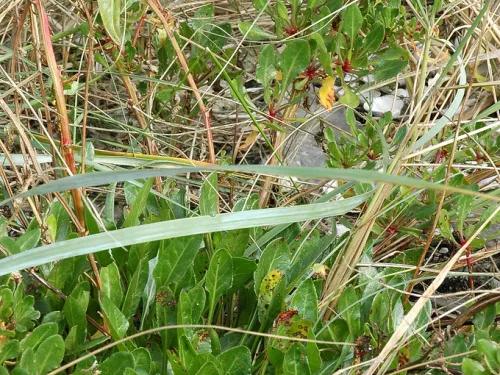
Sometimes called 'Wild spinach', Sea beet can be cooked and eaten. It grows wild on shingle beaches, cliffs and bare ground near to the sea, as well as in saltmarshes.
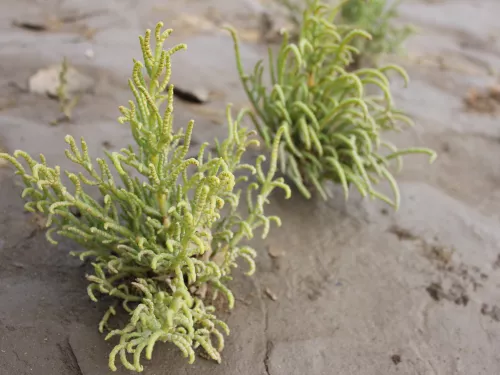
Sometimes called 'Marsh samphire', wild common glasswort is often gathered and eaten. It grows on saltmarshes and beaches, sometimes forming big, green, fleshy carpets.
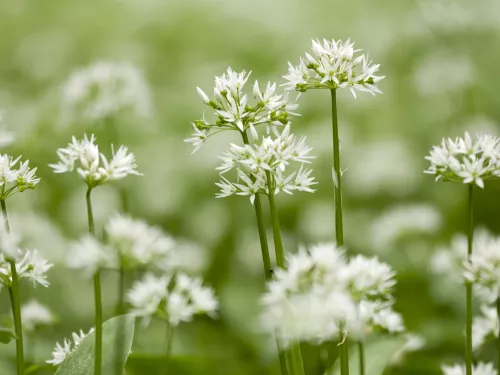
In April and May, our ancient woodlands are awash with the white, starry flowers and smell of wild garlic. Millions of bulbs can exist in just one wood, giving rise to dazzling 'white carpets'.
Perhaps the first sign that spring is just around the corner is the snowdrop poking its way through the frosted soil of a woodland, churchyard or garden. From January, look for its famous nodding, white flowers.
The bright yellow daffodils that adorn our roadsides and parks are likely to be garden varieties. Head to a woodland or damp meadow in North or South West England, or Wales, to see a true wild daffodil.
Look for the unusual flowers of lords-and-ladies in spring woodlands: a pale green sheath surrounds a spike of tiny, yellow flowers. This spike eventually forms a familiar, short stalk of striking red berries.
The vast, green mats that sometimes cover the surface of still water, such as ponds, flooded gravel pits and old canals, are actually Common duckweed. A tiny, single plant, it groups together to form 'lawns'.
A beautifully scented plant, the arching stems and bell-shaped flowers of Lily-of-the-valley can be seen in many woodlands. Despite its delicate appearance, this plant is highly toxic.
In April and May, our ancient woodlands are awash with the much-loved, nodding heads of the bluebell. Millions of bulbs can exist in just one wood, giving rise to the 'blue carpets' that are a springtime joy.
As its name suggests, Himalayan balsam is from the Himalayas and was introduced here in 1839. It now an invasive weed of riverbanks and ditches, where it prevents native species from growing.
The nodding, blue bells of the harebell are a summer delight of grasslands, sand dunes, hedgerows and cliffs. They are attractive to all kinds of insects, too.
With its fluffy-looking, light blue flower heads, sheep's-bit is a pretty plant of dry grassland, heaths and clifftops. Sometimes carpeting an area, it is popular with nectar-loving insects.
The yellow, star-like flowers of bog asphodel brighten up our peat bogs, damp heaths and moors in early summer, attracting a range of pollinating insects.
Look for the star-like, feathery, white flowers of Bogbean in ponds, fens, bogs and marshes. It is so-named because its leaves look like those of broad beans.
The drooping, tubular, pink flowers of Common comfrey are a familiar sight to many gardeners. Sometimes considered a 'weed', this hairy plant can be used as an organic fertiliser and a form of slug control.
Also known as 'Scorpion-grass' because of the curved 'tail' at the end of its stems, Water forget-me-not is a distinctive plant of damp habitats. Over summer, it produces clusters of sky-blue flowers.
Look for the pretty, azure-blue flowers of Wood forget-me-not along woodland rides and hedgerows, and in ancient and wet woodlands. Varieties of this flower for the garden are very popular.
The upright, blue flower spikes of Viper's-bugloss can be spotted on chalk grassland, sand dunes, cliffs and banks. Its spotted stem is thought to resemble a viper.
Brush through a wildflower meadow at the height of summer and you'll hear the tiny seeds of yellow-rattle rattling in their brown pods, hence its name.
Eyebright has small, white flowers with purple veins and yellow centres. It likes short grasslands, from clifftops to heaths, and is one of a number of species and hybrids that are hard to tell apart.
As its name suggests, Red bartsia does have a red tinge to its stem, leaves and small flowers. Look for it on roadside verges, railway cuttings and waste ground in summer.
Common cow-wheat is a delicate annual that brightens up the edges of acid woodland and heaths with deep golden flowers in the summer.
Once widespread, this attractive plant has declined as a result of modern agricultural practices and is now only found in four sites in South East England.
Broad-leaved dock is well-known to most of us as the remedy for Stinging nettle irritations. Often considered a 'weed', it can be found next to water or on disturbed ground almost anywhere.
As its name suggests, Water dock likes damp places, such as the egdes of canals, ponds and rivers. It is a tall plant with large, greenish flower spikes.
Curled dock is often considered a 'weed'. It can be found near water or on disturbed ground almost anywhere. It is similar to Broad-leaved dock, with which it can hybridise.
Common sorrel is a common plant of grasslands, woodland edges, roadside verges and gardens. It is also known as 'sour ducks' because its leaves taste tart.
Look for the delicate, pink flowers of Common bistort in wet meadows, pastures and roadside verges. It is also known as 'Pudding Dock' in North England because it was used to make a dessert at Eastertime.
Introduced from Japan in the 19th century, Japanese knotweed is now an invasive non-native plant of many riverbanks, waste grounds and roadside verges, where it prevents native species from growing.
Despite its name, Common knotgrass is not a grass, but is actually related to the docks. It has wiry stems that grow along the ground, and is a weed of waste ground, gardens and arable fields.
Herb-Paris has four oval leaves set in a cross, with an understated crown of yellow-green flowers rising from the middle. This makes it quite a distinctive plant of ancient and damp woodlands on chalky soils.
Once considered a weed of cornfields, the Pheasant's-eye was nearly wiped out by intensive agricultural practices. Today, it can be found in deliberately seeded areas, and on roadside verges and waste ground.
Creeping buttercup is our most familiar buttercup - the buttery-yellow flowers are like little drops of sunshine peppering garden lawns, parks, woods and fields.
Meadow buttercup is a tall and stately buttercup, with buttery-yellow flowers that pepper meadows, pastures, gardens and parks with little drops of sunshine.
Look out for the small, yellow flowers of Celery-leaved buttercup in wet meadows and at the edges of ponds and ditches. It flowers from May to September.
Heralding spring, a carpet of sunshine-yellow lesser celandine flowers is a joy to see on a woodland walk. Look out for it along hedgerows, in parks and even in graveyards, too, from March onwards.
The large, golden flowers of Marsh-marigold look like the cups of kings, hence its other name: 'Kingcup'. It favours damp spots, like ponds, meadows, marshes, ditches and wet woodlands.
The bonnet-shaped, violet-blue flowers of Columbine can be spotted in damp areas in woodlands and in fens. It is also an attractive and much-loved garden plant.
The fluffy, white seed heads of Traveller's-joy give it the evocative, alternative names of 'Old Man's Beard' and 'Father Christmas'. A clematis-like climber, it can be seen scrabbling over hedgerows and in woods.
A spring delight, the wood anemone grows in dappled shade in ancient woodlands. Traditional management, such as coppicing, can help such flowers by opening up the woodland floor to sunlight.
The bulbous buttercup has the familiar butter-yellow flowers of its namesake, but grows from a bulb-like 'corm' (a swollen underground stem). Look for it on chalk and limestone grasslands, and along verges.
A member of the buttercup family, Common water-crowfoot displays white, buttercup-like flowers with yellow centres. It can form mats in ponds, ditches and streams during spring and summer.
So-named for its spear-like leaves, Lesser spearwort can be found along the edges of ponds, lakes and streams, and in marshes and wet meadows. As a buttercup, it displays familiar, butter-yellow flowers.
Hedge mustard is a tall plant with small, yellow flowers atop tough stems. It likes disturbed ground and grows in hedgerows and roadside verges, and on waste ground.
Favouring shady spots in woodlands and hedgerows, Garlic mustard can grow very tall. It has small, white flowers and, as its name suggests, smells faintly of garlic.
Water-cress has become so popular as a salad addition that it is now cultivated on a wide scale. In the wild, it grows in shallow, fast-flowing streams and is an indicator of clean water.
Hairy bitter-cress is an edible weed of rocky places, walls, gardens and cultivated ground. Gathering wild food can be fun, but it's best to do it with an expert - come along to a Wildlife Trust event to try it.
Shepherd's purse is often considered a 'weed'. It produces a lot of seeds and can be found on cultivated and disturbed land, such as arable fields, tracks and gardens.
Horseradish is used as a well-loved condiment. This member of the cabbage family is actually an introduced species in the UK, but causes no harm in the wild.
The papery, translucent, silver 'coins' of Honesty are instantly recognisable. They are actually the leftover seed pods that dangle from the plant through winter.
A sure sign that spring has arrived, the Cuckooflower blooms from April. Look out for its delicate, pale pink flowers in damp meadows and ditches, and on riverbanks.
Dittander is a herb of coastal saltmarshes and damp ground. Its waxy leaves and long roots help it to survive in this harsh environment. Due to its peppery taste, it has also become a popular garden plant.
The spiky, silvery leaves of Sea-holly give this plants its common name. Look for its beautiful, thistle-like, blue blooms on coastlines and sand dunes in summer.
The umbrella-like clusters of white, frothy flowers of cow parsley are a familiar sight along roadsides, hedgerows and woodland edges.
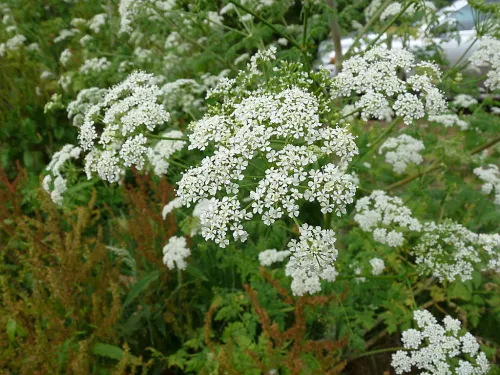
A notoriously poisonous plant, hemlock produces umbrella-like clusters of white flowers in summer. It can be found in damp places, such as ditches, riverbanks and waste ground.
Pignut is a small umbellifer, with edible tubers, that is found in woods, hedges and grasslands.
Ground-elder was likely introduced into the UK by the Romans and has since become naturalised. A medium-sized umbellifer, it is an invasive weed of shady places, gardens and roadsides.
Fennel has feathery leaves and open, umbels of yellow flowers. It was probably introduced by the Romans for culinary use, and is now a naturalised species of verges, waste ground and sand dunes.
As its name suggests, giant hogweed it a large umbellifer with distinctively ridged, hollow stems. An introduced species, it is an invasive weed of riverbanks, where it prevents native species from growing.
Hogweed can be found along hedgerows and roadside verges, and on waste ground and rough grassland. It displays umbrella-like clusters of creamy-white flowers. It's native, unlike its relative, Giant Hogweed.
Wild carrot does, indeed, smell of carrots, but the roots are not like our cultivated, dinnertime favourite. Look for this umbellifer on chalk grasslands and coasts.
The red-tinged, flower clusters of Wild angelica smell just like the garden variety, which is used in making cake decorations. Wild angelica likes damp places, such as wet meadows and wet woodlands.
Pepper saxifrage is a classic plant of unimproved hay meadows and roadside verges. It's upright, branching stems carry umbrella-like clusters of creamy-yellow, flowers in summer.
Look out for the white, umbrella-like flower heads of lesser water-parsnip along the shallow margins of ditches, ponds, lakes and rivers. When crushed, it does, indeed, smell like parsnip!
Large scale drainage in the UK has seen a massive reduction in the range of this sensitive aquatic plant which now only occurs in around 50 sites in England.
A late-blooming flower, Meadow saffron looks like a crocus, displaying similar pink flowers once its leaves have died back. It is a highly poisonous plant of meadows and woodland rides and clearings.
The bill-shaped seed pods of Common Stork's-bill explode when ripe, sending the seeds flying! This low-growing plant has pretty pink flowers and can be seen on grasslands and coastal sands.
Meadow crane's-bill has striking violet flowers that pepper hay meadows, verges and grasslands with colour in summer. It is also a popular choice for gardeners and attracts a wide variety of bees.
Bloody crane's-bill has striking magenta flowers that pepper our rare limestone pavements, grasslands and sand dunes with summer colour. It is a favourite of all kinds of insects, including bumblebees.
Herb-robert is a low-growing plant, with small, pretty, pink flowers. Look for it in shady spots in woodland, hedgerows and coastal areas.
An introduced species, Common evening-primrose is now naturalised on waste ground, roadside verges and railway cuttings. It has long been used to produce the herbal remedy, evening-primrose oil.
A tall and hairy plant, Great willowherb displays pretty pink-and-cream flowers. It can be found in damp places, such as wet grasslands, ditches and riversides.
A tall plant, Rosebay willowherb is a successful coloniser; it can form dense stands of bright pink flower spikes on disturbed ground, such as woodland clearings, verges and waste ground.
Enchanter's nightshade is a hairy plant, with rounded leaves that taper to a fine tip, and clusters of small, pinky-white flowers in summer.
Great mullein is an impressive, tall plant of waste ground, roadside verges and gardens. Its candle-like flower spikes rise from rosettes of furry, silver-green leaves.
Water figwort is a tall plant of riverbanks, pond margins, damp meadows and wet woodlands. Its maroon flowers are pollinated by the Common wasp.
A small and delicate plant of chalk grasslands, Fairy flax can be seen in bloom from May to September - look out for its nodding, white flowers.
Flowering rush is a pretty rush-like plant of shallow wetland habitats, such as ponds, canals and ditches. Its cup-shaped, pink flowers appear in summer, brightening up the water's edge.
Frogbit looks like a mini water-lily as it floats on the surface of ponds, lakes and still waterways. It offers shelter to tadpoles, fish and dragonfly larve.
Water-soldier grows submerged in ponds and open water, and pops up over summer, looking like the top of a pineapple! This rare plant displays white flowers and shelters many aquatic insects.
A plant of chalk and limestone grasslands and sand dunes, Yellow-wort has butter-yellow flowers. Its distinctive leaves sit opposite each other, but are fused together around the stem.
A low-growing plant of sand dunes, heaths and grassy places, Common centaury is in bloom over summer. Look for clusters of pretty, pink, five-petalled flowers.
Often overlooked, Lesser centaury is a tiny plant of grassy, open habitats like dunes, cliffs, heaths and grasslands. As its name suggests, it is much smaller than its relative, Common centaury.
The early gentian is a rare plant that is only found in the UK. It likes sunny, lowland chalk grasslands, its purple, trumpet-shaped flowers blooming in May and June.
A late-flowering plant, Autumn gentian displays pretty, mauve, tube-like flowers atop its reddish stems. It favours dry, chalk grassland and sand dune habitats.
The bright blue, trumpet-shaped flowers of the marsh gentian contrast deeply with the pinks and purples of the wet heaths it inhabits. The New Forest holds a large population of this late-flowering plant.
A climbing plant of hedgerows and woodlands, White bryony produces greenish flowers in summer and red, shiny berries in winter. It is a poisonous plant.
The stately Grass-of-parnassus displays pretty, white flowers with green stripes. Once widespread, it is now declining as its wetland habitats are disappearing.
Cross-leaved heath is a type of heather that likes bogs, heathland and moorland. It has distinctive pink, bell-shaped flowers that attract all kinds of nectar-loving insects.
Bell heather is our most familiar heather. In summer, it carpets our heaths, woods and coasts with purple-pink flowers that attract all kinds of nectar-loving insects.
Heather is also called 'ling'. Look for it on our heaths, moors and bogs, where its delicate, loosely arranged pink flowers attract all kinds of nectar-loving insects.
Well-known for its role in making beer, Hop is a climbing plant that can be seen in woodlands and along hedgerows and field edges. Its female flowers bear the cone-like fruit that is used in beer.
A prickly, tall plant, the Small teasel is closely related to the Common teasel, but has much smaller, more rounded flower heads. It prefers damp, open woodlands.
A true wildlife 'hotel', Honeysuckle is a climbing plant that caters for all kinds of wildlife: it provides nectar for insects, prey for bats, nest sites for birds and food for small mammals.
Red valerian was introduced in the 1600s from Europe, but is now naturalised in the UK. Its pinky-red flowers grow from old walls, roadside verges, railway cuttings and cliffs, and provide nectar for insects.
The pincushion-like, lilac-blue flower heads of Devil's-bit scabious attract a wide variety of butterflies and bees. Look for this pretty plant in damp meadows and marshes, and on riverbanks.
The brown, oval, spiky seed heads of the teasel are a familiar sight in all kinds of habitats, from grassland to waste ground. They are visited by goldfinches and other birds, so make good garden plants.
The large, sunshine-yellow flowers of the yellow iris brighten up the margins of our waterways, ponds, wet woods, fens and marshes. Also called the 'flag iris', its outer petals have a characteristic 'droop'.
Ivy is one of our most familiar plants, seen climbing up trees, walls, and along the ground, almost anywhere. It is a great provider of food and shelter for all kinds of animals, from butterflies to bats.
Cushions of clover-like, pink Thrift are a familiar sight of cliffs, shingle beaches and sand dunes around the UK. Also known as 'Cliff Clover', it makes a good garden plant.
Common sea-lavender can be found around our coasts on mudflats, creek banks and saltmarshes. Despite its name, its not a lavender at all, so doesn’t smell like one.
The small, yellow flowers and woolly appearance of kidney vetch make this plant easy to spot. Look for it growing low to the ground on sand dunes, chalk grasslands and cliffs in summer.
Look for the small, pink, pea-shaped flowers of Common restharrow on chalk and limestone grasslands, and in coastal areas, during summer.
A familiar 'weed' of gardens, roadsides, meadows and parks, White clover is famous for its trefoil leaves - look out for a lucky four-leaf clover in your own garden!
The downy hairs that cover the pale pink flowers of Hare's-foot clover give it the look of a Hare's paw - hence the common name. Look out for this clover around the coast and on dry grasslands.
A familiar 'weed' of gardens, roadsides, meadows and parks, red clover has trefoil leaves and red, rounded flower heads. It is often used as fodder for livestock.
Common bird's-foot-trefoil has a vareity of names that conjure up some interesting images: 'Eggs and Bacon', for instance! Its small, yellow, slipper-like flowers can be seen in all kinds of grassy places.
Tall melilot was introduced into the UK as a fodder crop, but has now become naturalised. It displays golden, pea-like flowers on tall spikes, which are followed by black, hairy seed pods.
A scrambling plant, Tufted vetch has violet flowers. It is a member of the pea family and can be seen along woodland edges, on scrubland and grassland, and at the coast.
A scrambling plant, Bush vetch has lilac-blue flowers. It is a member of the pea family and can be seen along woodland edges and roadside verges, and on scrubland and grassland.
A scrambling plant, Common vetch has pink flowers. It is a member of the pea family and can be seen on grassland, farmland and waste ground, as well as at the coast.
A scrambling plant, Meadow vetchling has yellow flowers. It is a member of the pea family and can be seen on rough grassland, waste ground and roadside verges.
Dyer's greenweed is a classic plant of hay meadows, heaths and open woodlands. It has upright stems with loose clusters of bright yellow, pea-like flowers in summer.
A sprawling plant, wild liquorice often has large, kinked stems. It favours woodland, scrub and grassland habitats on chalky soils - look for pea-like flowers and pods. This liquorice is not edible, though!
Horseshoe vetch is a member of the pea family, so displays bright yellow, pea-like flowers and seed pods. Look for this low-growing plant on chalk grasslands from May to July.
The nodding, pink-and-purple-chequered flowers of the snake's-head fritillary are said to resemble a snake, hence the name. Declining with the loss of our meadows, this delicate plant can be seen in spring.
A tall plant, purple-loosestrife can form dense stands of bright purple flower spikes in wet habitats like reedbeds, fens and marshes.
In summer, the 'frothy' flowers of lady's bedstraw can carpet the grasses of meadows, heaths and coasts with yellow and fill the air with a sweet, honey-like scent.
Crosswort gets its name from the position of its leaves - they surround the stem in groups of four, making a cross shape. The tiny, yellow flowers sit atop these crosses and bloom from April to June.
Familiar as the bristly plant that easily hooks on to our clothing as we walk through the countryside or do the gardening, cleavers uses its hooks to help it climb and to disperse its seeds.
Common mallow is a handsome 'weed' of waste ground, roadside verges and gardens. Its deep pink, stripey flowers provide nectar for insects throughout the summer.
Musk mallow has pretty pink flowers that can be seen along roadside verges, hedgerows and field margins in summer. It lives up to its name, producing a delicate, musky smell that increases indoors.
The dark-blue flowers of Common milkwort pepper our grasslands from May to September. It can also appear in pink and white forms.
Dwarf milkwort is a rare plant of chalk and limestone grasslands with short turf; it can mainly be found in Kent, Yorkshire and Cumbria. It has bluish, sometimes pink, flowers atop its short stems.
The delightful fragrance of wild thyme can punctuate a summer walk over a chalk grassland. It forms low-growing mats with dense clusters of purple-pink flowers.
Water mint grows in damp places and has aromatic leaves that can be used to flavour food and drink. Gathering wild food can be fun, but it's best to do it with an expert - come to a Wildlife Trust event to try it.
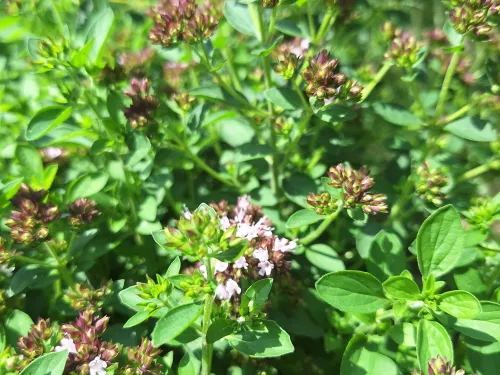
Wild marjoram is actually the same aromatic herb as oregano which is used in Mediterranean cooking. Its small, pink flower clusters can be seen on chalk and limestone grasslands in summer.
The aromatic fragrance of Large thyme can punctuate a summer walk over a chalk grassland. It is an evergreen that grows low to the ground, with erect spikes of tiny, lilac flowers appearing over summer.
Selfheal is a low-growing, creeping plant that likes the short turf of grasslands, roadside verges or even lawns. Its clusters of violet flowers appear in summer.
The pungent, rotten smell of Black Horehound makes this medium-sized plant of waste ground and roadside verges stand out from the crowd.
As the bluebells fade, yellow archangel takes its turn to impress, with golden-yellow flowers carpeting our ancient woodlands.
The unpleasant, astringent smell of Hedge woundwort makes this medium-sized plant of woodlands, hedgerows and roadside verges stand out from the crowd.
Despite the family it's from, White dead-nettle does not sting. It displays dense clusters of white flowers in whorls around its stem, and can be found on disturbed ground, such as roadside verges.
Despite the family it's from, red dead-nettle does not sting. It displays dense clusters of pinky-red flowers in whorls around its stem, and can be found on disturbed ground, such as roadside verges.
Despite its name, Ground-ivy is actually a member of the dead-nettle family. It is a clump-forming, aromatic plant that likes woodlands, hedgerows and damp places.
The delicate, tube-like, violet-blue flowers of Skullcap bloom from June to September in damp places, such as marshes, fens, riverbanks and pond margins.
Despite having the familiar sage-green leaves, Wood sage has very little scent, so is not a good cooking herb. It can be found on acidic soils on sand dunes, heaths and cliffs, and along woodland rides.
Often found carpeting damp grassland and woodland clearings, the blue flower spikes of bugle are very recognisable. A short, creeping plant, it spreads using runners.
Kissing under the mistletoe is a much-loved Christmas tradition, making this plant familiar to us all. It actually grows as a parasite on trees - look for it hanging off branches in large balls during winter.
A creeping and climbing plant of cultivated ground, Field Bindweed can become a pest in places as it stops other plants from growing. It has creamy, sometimes striped, large flowers, and arrow-shaped leaves.
A climbing plant of woodlands, hedgerows, riverbanks and gardens, Hedge bindweed can become a pest in some places. It has large, trumpet-shaped, white flowers and arrow-shaped leaves.
The stinging nettle is a familiar and common plant, often firmly rooted in our memories after our first, hands-on experience - a prickling irritation that's not forgotten easily!
Pellitory-of-the-wall is a small to medium-sized herb that frequently grows from cracks in old stone walls, pavements, cliffs and banks, and churches and ruins.
As its name suggests, Deadly nightshade is a highly poisonous plant. Its black, shiny berries may be tempting but fatal. Found on chalky and disturbed ground, such as scrub or verges, it has bell-shaped flowers.
Bittersweet is a nightshade, so is toxic; its bright red berries may be tempting, but can cause serious illness. Found in hedgerows and gardens, it has purple flowers with yellow stamens.
The Common fragrant-orchid lives up to its name: it produces a sweet, orangey smell that is very strong in the evening. Look for its densely packed, pink flower spikes on chalk grasslands in summer.
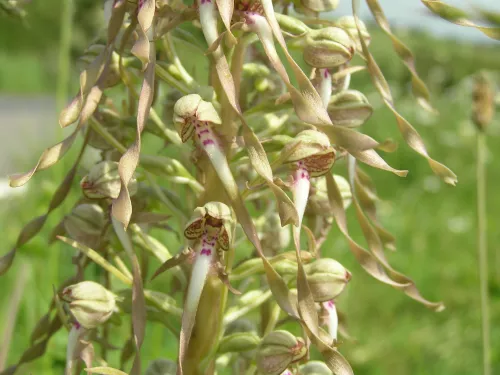
The petals of the rare Lizard orchid's flowers form the head, legs and long tail of a lizard. They are greenish, with light pink spots and stripes, and smell strongly of goats! Spot this tall plant on chalk grasslands and dunes in the South East.
The common spotted-orchid is the easiest of all our orchids to see: sometimes, so many flowers appear together that they create a pale pink carpet in our woodlands, old quarries, dunes and marshes.
The Marsh helleborine is a beautiful orchid of fens, wet grassland and dune slacks. Growing in profusion in places, look for reddish stems and white-and-pink flowers.
A tall orchid of woodland and scrub, the broad-leaved helleborine has greenish, purple-tinged flowers that look a little 'drooping'. Strongly veined, oval leaves spiral around its stem.
A short, but pretty plant of unimproved grasslands, the Green-winged orchid gets its name from the green veins in the 'hood' of its flowers. Look for it in May and June.
The Greater butterfly-orchid is a tall orchid of hay meadows, grasslands and ancient woodlands. It has whitish-green flowers that have spreading petals and sepals - a bit like the wings of a butterfly.
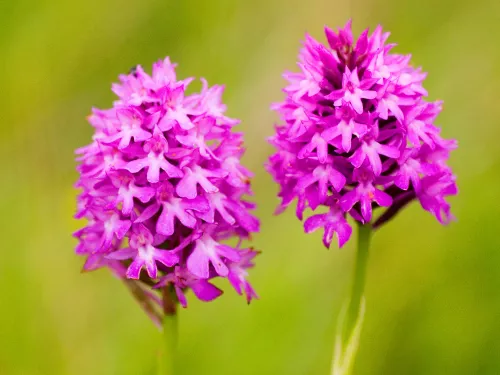
The Pyramidal orchid lives up to its name - look for a bright pinky-purple, densely packed pyramid of flowers atop a green stem. It likes chalk grassland, sand dunes, roadside verges and quarries.
An easily overlooked orchid, the Common twayblade is yellow-green and less showy than other UK orchids. Look for it in woodlands and grasslands on chalky soils, in particular.
The Bird's-nest orchid gets its name from its nest-like tangle of roots. Unlike other green plants, it doesn’t get its energy from sunlight. Instead, it grows as a parasite on tree roots, so its brownish-yellow flowers look a bit sickly.
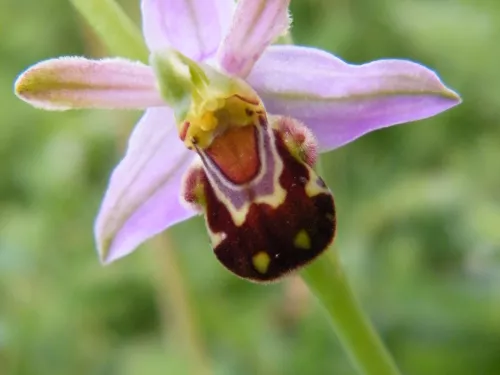
The bee orchid is a sneaky mimic - the flower’s velvety lip looks like a female bee. Males fly in to try to mate with it and end up pollinating the flower. Sadly, the right bee species doesn’t live here, so this orchid is self-pollinated in the UK.
The Early purple orchid is one of the first orchids to pop up in spring. Look for its pinkish-purple flowers from April, when bluebells still carpet our woodland floors. Its leaves are dark green with dark spots.
This is probably the most widespread and commonest of the marsh orchids.
The fly-shaped flowers of this fascinating plant are attractive to insects - but not the ones you might expect!
The pretty Deptford pink is a very rare flower that is very vulnerable to the loss of our traditional grassland and farmland habitats. It can only be found in a few places in England and Wales.
Bladder campion is so-called for the bladder-like bulge that sites just behind the five-petalled flower - this is actually the fused sepals. Look for it on grasslands, farmland and along hedgerows.
The pink, frayed flowers of Ragged-robin are an increasingly rare sight as our wild wetland habitats disappear. You can help: grow native plants in your garden and enjoy the hum of visiting insects.
Star-of-Bethlehem' and 'wedding cakes' are just some of the other names for greater stitchwort. Look for its pretty, star-shaped, white flowers in woodlands and along hedgerows and roadside verges.
Look for the small, white, star-shaped flowers of Common chickweed all year-round. Sometimes considered a 'weed', it is still a valuable food source for insects.
Common mouse-ear is a persistent 'weed' of fields and gardens, verges and hedgerows - all kinds of habitats. But, like many of our weed species, it is still a good food source for insects.
Traditionally a coastal species, Lesser sea-spurrey has spread inland, taking advantage of the winter-salting of our roads. Its pink-and-white flowers bloom in summer.
Look for the pretty, star-shaped, white flowers of Lesser stitchwort in woodlands and meadows, and along hedgerows and roadside verges in spring. Its flowers are smaller than those of Greater stitchwort.
At night, the pretty, white blooms of white campion produce a heady scent, attracting feeding moths. Look for this wildflower along hedgerows and roadside verges, and on waste ground.
Just as the bluebells finish flowering in our woodlands, the rose-red blooms of red campion start to brighten up the woodland floor. Look for this pretty plant in hedges and roadsides, too.
If you happen to be near rocky places such as sea cliffs, shingle coastlines or even gravel paths during the summer months you will most likely come across sea campion.
A good luck charm for travellers, Germander speedwell can be seen along roadsides, grassy lanes and hedgerows. Look for clumps of bright blue flowers.
The Foxglove is a familiar, tall plant, with pink flower spikes and a deadly nature. In summer, it can be spotted in woodlands and gardens, and on moorlands, roadside verges and waste grounds.
A fleshy herb of the wet margins of brooks, streams and ditches, Brooklime can be seen all year-round and provides shelter for tadpoles and sticklebacks.
A 'weed' of cultivated and disturbed ground, Round-leaved fluellen is a trailing plant with round leaves and yellow flowers that appear over summer.
Ivy-leaved toadflax is an introduced species in the UK that has become widely naturalised. Look for creeping along old walls and pavements, and shingle beaches. Its flowers resemble those of snapdragons.
Pushing its way up through the cracks in pavements, the straw-coloured flower spikes of greater plantain or 'broadleaf plantain' are a familiar sight. This 'weed' also pops up in lawns, on roadsides and along field edges.
Look for common toadflax on waste ground and grassland, and along roadside verges and hedgerows. Its yellow-and-orange flowers are tightly packed on a tall spike and have distinctive 'spurs'.
The brown, oval flower heads of ribwort plantain balance on top of thin, wiry stems; the resulting seed heads provide food for birds in winter. Look for this 'weed' in lawns, fields and grasslands.
Once considered a weed of cornfields, the Common poppy is now in decline due to intensive agricultural practices. It can be found in seeded areas, on roadside verges and waste ground, and in field margins.
The Welsh poppy is a plant of damp and shady places, roadsides and hillsides. It is also a garden escapee. It flowers over summer, attracting nectar-loving insects.
Easily recognised in its beach habitat, the Yellow horned-poppy is so-named for its long, curving seedpods that look like horns! Look for golden-yellow flowers in June.
Greater celandine is a very common plant that spreads easily in the garden, on waste ground and in hedgerows. It is considered a weed, but the small, yellow flowers provide nectar for insects.
A scrambling 'weed' of waste ground, fields and gardens, Common fumitory can be found on dry and disturbed soils. Its pink flowers appear over spring and summer.
Yellow corydalis is a familiar 'weed' of gardens, walls and rocky places. It is a garden escapee in the UK, so is not a native plant. Try choosing natives for your garden to prevent species escaping into the wild.
In mild years, the spring-flowering primrose can appear as early as December. Look out for its pretty, creamy-yellow flowers in woodlands and grasslands.
One of our most familiar spring flowers, the cowslip brightens up ancient meadows and woodlands with its egg-yolk-yellow, nodding blooms.
Creeping jenny is a low-growing plant of wet grasslands, riverbanks, ponds and wet woods. It has cup-like, yellow flowers and is a popular choice for garden ponds.
Once considered a weed of cornfields, the Scarlet pimpernel is now in decline due to intensive agricultural practices. It can be found in arable fields, on roadside verges and waste ground, and on coastal cliffs.
Golden banks of common rock-rose make a spectacular sight on our chalk and limestone grasslands in summer. A creeping shrub, it is good for bees, moths and butterflies.
The flowers of Opposite-leaved golden saxifrage form 'trickles of gold' along riverbanks and streamsides in shady areas like wet woodlands.
Look for the deep magenta, star-shaped flowers of Marsh cinquefoil in marshes, bogs, fens and wetlands in the north, west and east of the UK.
As its name suggests, Meadowsweet is a sweet-smelling flower of damp meadows, ditches and riverbanks. Look for frothy clusters of cream flowers on tall stems.
The bramble is the thorny shrub of hedges, woods and scrub that gives us delicious blackberries in autumn. Gathering wild food can be fun, but it's best to do it with an expert - come along to a Wildlife Trust event to try it.
Look for wood avens along hedgerows and in woodlands. Its yellow flowers appear in spring and provide nectar for insects; later, they turn to red, hooked seedheads that can easily stick to a passing animal.
Look for Water avens in damp habitats, such as riversides, wet woodlands and wet meadows. It has nodding, purple-and-orange flowers that hang on delicate, purple stems.
The Wild strawberry produces miniature, edible versions of the juicy red fruits we so enjoy. Gathering wild food can be fun, but it's best to do it with an expert - come along to a Wildlife Trust event to try it.
As its name suggests, Silverweed has silvery leaves with toothed edges. It can be found in grassy places, along roadsides and on waste ground - look for yellow, saucer-shaped flowers and red runners.
Tormentil can be found growing on acid grassland, heathland and moorland, but even pops up alongside roads. It bears yellow, buttercup-like flowers, but with only four petals (buttercups have five).
The egg-shaped, crimson flower heads of Great burnet give this plant the look of a lollipop! It can be found on floodplain meadows - a declining habitat which is under serious threat.
A low-growing herb of chalk and limestone grassland, Salad burnet lives up to its name - it is a popular addition to salads and smells of cucumber when crushed!
Often seen carpeting the floor of ancient woodlands, Dog's mercury can quickly colonise, its fresh green leaves shading out rarer plants. It is also very poisonous.
As its name suggests, Wood spurge is found in woodlands. It is an attractive evergreen that displays cup-shaped, green flowers in clusters and dark green leaves.
As its name suggests, Sea spurge is found at the coast. It is an attractive plant that displays cup-shaped, greeny-yellow flowers and fleshy, grey-green leaves.
Petty spurge is found on cultivated ground, such as gardens, fields and waste ground. It displays cup-shaped, green flowers in clusters and oval, green leaves.
Toadflax-leaved St John's-wort has star-shaped, bright yellow flowers. It is a rare plant, with most of its population existing on Dartmoor. It likes steep, sunny slopes, acidic soils and plenty of space.
The subject of much myth and legend, and a herbal remedy, Perforate st John's-wort is a familiar flower. It has star-shaped, bright yellow flowers and lots of tiny holes in its leaves that give off a 'foxy' smell.
Also known as 'Goldmoss' due to its dense, low-growing nature and yellow flowers, Biting stonecrop can be seen on well-drained ground like sand dunes, shingle, grasslands, walls and pavements.
The disc-shaped leaves and straw-coloured flower spikes of Navelwort help to identify this plant. As does its habitat - look for it growing from crevices in rocks, walls and stony areas.
The carnivorous lifestyle of the round-leaved sundew makes this heathland plant a fascinating species. The round leaves have sticky, 'dew'-covered tendrils that tempt in unsuspecting insects as prey.
Chamomile releases a beautiful, apple-like scent when crushed. For this reason, it was used in Elizabethan times as a plant for lawns and seats! Today, it is scarce in the wild, its grassland habitats under threat.
A common thistle of roadside verges, rough grassland and waste ground, the Musk thistle has large, purple, nodding flower heads that appear in summer. It is attractive to a wide range of insects.
Look for the round, cottony, purple flower heads of the Woolly thistle on chalk and limestone grasslands in summer. It is mainly found in Southern England.
Despite being considered a 'weed' of cultivated ground, the seeds of the Creeping thistle provide an important food source for farmland birds, many of which are declining rapidly.
A common plant of disturbed ground like roadside verges and field edges, the spear thistle has purple, fluffy flower heads that appear in summer. Its flowers attract insects and its seeds feed birds.
The Carline thistle produces distinctive brown-and-golden flower heads that look like a seeded thistle. These flowers are attractive to a wide range of butterflies, including the very rare Large blue.
The ragged-edged, purple flower heads of Greater knapweed bloom on sunny chalk grasslands and clifftops, and along woodland rides. They attract clouds of butterflies.
The tightly packed, thistle-like purple flower heads of common knapweed bloom on all kinds of grasslands. Also regularly called 'black knapweed, this plant attracts clouds of butterflies.
The common dandelion is a most familiar flower: counting down the 'clock', while blowing the fluffy seeds from its head, is a favourite childhood game. Dandelions are an important early source of food for pollinators - so let them grow!
Looking a bit like a ragged version of a dandelion, mouse-ear hawkweed has lemon-yellow flower heads that are tinged with red at their outer edges. It likes grassy places with short turf and chalky soils.
On first glance, the meadow thistle looks a bit like a knapweed - it's not as prickly as other thistles and only carries one pinky-purple flower head. It can be found in damp meadows and grasslands.
As its name suggests, the Dwarf thistle is a low-growing plant that is almost stemless - its purple, thistle-like flower heads growing out of a rosette of spiny leaves.
A renowned 'weed' of paddocks, pastures and waste ground, the yellow flower heads of common ragwort are actually highly attractive to bees and other insects, including the cinnabar moth.
Groundsel is a 'weed' of cultivated and disturbed ground like field edges, roadside verges and waste ground. It has clusters of yellow flowers that turn fluffy and white as the plant seeds.
Looking like a short Dandelion, but with a much rounder middle, Colt's-foot is a 'weed' of waste ground and field edges that brightens up early spring with its sunshine-yellow flower heads.
He loves me, he loves me not' is a familiar rhyme associated with what is probably our most well-known plant: the common daisy. Its white-and-yellow flower heads brighten up lawns, verges and short turf almost everywhere.
Pineappleweed is an introduced species that has become a widespread 'weed' of disturbed ground, such as pavements and roadsides and gardens. It has feathery leaves and yellow flower heads.
Yarrow can be found in many grasslands, from lawns to meadows, its flat-topped clusters of flower heads appearing from June. Cultivated varieties are garden favourites.
Also known as 'Raspberries and Cream', Hemp-agrimony displays 'frothy' clusters of tiny, pink flowers on top of long, reddish stems. Its leaves look like those of Hemp, although it is not related.
Tansy is an aromatic plant of rough grassland, riverbanks and verges that has button-like, yellow flower heads. It is the main foodplant of the rare Tansy Beetle, now found at only two places in the UK.

Often growing in swathes along a roadside or field margin, the oxeye daisy is just as at home in traditional hay meadows. The large, white, daisy-like flowers are easy to identify.
Greater burdock is familiar to us as the sticky plant that children delight in, frequently throwing the burs at each other. It actually uses these hooked seed heads to help disperse its seeds.
Once considered a weed of cornfields, the cornflower was nearly wiped out by intensive agricultural practices. Today, it can be found in deliberately seeded areas, and on roadside verges and waste ground.
An introduced plant, vervain is widely naturalised in the UK. It is a great source of nectar for all kinds of insects and can be seen on rough grassland, waste ground, coastal cliffs and roadside verges.
With its familiar features, the Field pansy is a delicate version of a garden favourite. Usually creamy-yellow in colour, it can be seen in fields and on roadside verges and waste ground.
Living up to its name, the hairy violet is covered in fine hairs. Look for its delicate, violet flowers blooming from March to June on chalk grasslands, in particular.
A pale member of the violet family sometimes known as ‘milk violet’, the fen violet has a delicate and unassuming appearance. A real specialist of the wetland habitat, this species has seen a massive decline in population due to habitat loss and draining…
Look for the White water-lily in still and slow-moving water, such as ponds, ditches, lakes and canals. Its lily pads and massive, white flowers float at the water's surface.
Look out for the feathery leaves of Spiked water-milfoil just below the surface of streams, ditches, lakes and ponds; its red flowers emerge from the water in summer. It provides shelter for a range of aquatic wildlife.
Water-plantain is an aquatic plant of shallow water and muddy banks. In bloom over summer, it displays tall branches of loosely clustered, pale lilac flowers.
Arrowhead is an aquatic plant of shallow water and slow-moving waterways. In bloom over summer, it displays small, white flowers, but it is the arrow-shaped leaves that are most distinctive.
A delicate, small plant of woodlands and hedgerows, wood-sorrel has distinctive, trefoil leaves and white flowers with purple veins; both fold up at night.
A climbing plant of hedgerows and woodlands, Black bryony produces greenish flowers in summer and red, shiny berries in autumn. It is a poisonous plant.